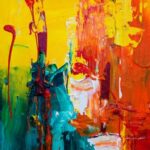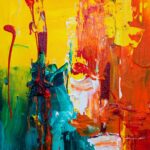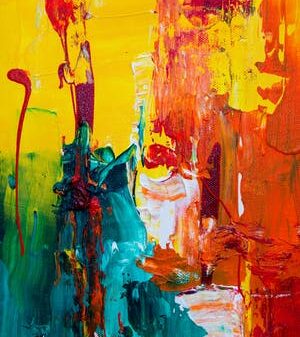Abstract art has been captivating audiences for decades, leaving viewers in awe of the beauty that can be created through non-representational expression. While some may struggle to understand its message or purpose, others appreciate the freedom and creativity that abstract art allows. In this blog post, we will explore the beauty of abstract art and how it encourages us to break away from traditional ways of thinking about art and embrace a world of imagination and limitless possibilities. So sit back, relax, and let’s dive into the fascinating world of non-representational expression!
Introduction to Abstract Art
Abstract art is often thought of as non-representational and difficult to understand. But, at its core, abstract art is simply a visual language that uses color, form, line, and texture to create a composition. It is up to the viewer to interpret the meaning of the work.
While representational art seeks to depict the world around us, abstract art embraces non-representational expression. Abstract artists may use geometric shapes, organic forms, or gestural marks to create their compositions. The goal is not to recreate reality but rather to communicate an idea or feeling.
Abstract art can be challenging for viewers who are used to looking for representational cues in artwork. But, by taking the time to look closely at an abstract painting or sculpture, you may find yourself discovering new meanings and enjoying the beauty of non-representational expression.
History and Different Schools of Abstract Art
Different schools of abstract art emerged in the early 20th century, each with its own distinct approach to non-representational expression. The earliest and most influential school was led by Russian artist Kazimir Malevich, who developed the style known as Suprematism. This approach was characterized by simple, geometric forms and stark color contrasts.
Other important schools of abstract art include Abstract Expressionism, Color Field Painting, and Minimalism. Abstract Expressionism was pioneered by American artists such as Jackson Pollock and Mark Rothko. This style is characterized by gestural brushwork and intense colors. Color Field Painting was developed by artists like Helen Frankenthaler and Barnett Newman. It is characterized by large fields of flat color. Minimalism emerged in the 1960s and was spearheaded by artists like Carl Andre and Donald Judd. This approach is defined by its use of simple geometric forms and industrial materials.
Despite their differences, all schools of abstract art share a dedication to non-representational forms and exploration of the formal elements of painting. Abstract art continues to evolve today, with new approaches such as Neo-Expressionism and Neo-Geo.
Benefits of Abstract Art
Abstract art is often seen as mysterious, and even intimidating. But there are many benefits to be found in non-representational expression. Abstract art can help us to see the world in new ways, to find the hidden beauty in the every day, and to explore emotions and ideas that we might not be able to put into words.
Some people may think that abstract art is simply random or chaotic. But there is usually a method to the madness. Many abstract artists start with a real-world subject and then distort it or break it down into its basic elements. This can help us to see the world around us in new ways.
Abstract art can also be a way of exploring emotions or ideas that are difficult to put into words. When we look at an abstract painting, we may not see anything recognizable at first. But as we spend more time with it, we may start to see shapes or colors that remind us of something – an experience, a memory, a feeling. In this way, abstract art can help us to access parts of ourselves that we might not be able to express in any other way.
Finally, abstract art can be a source of inspiration. It can help us to find beauty in the unexpected and to explore our own creativity. We might find ourselves creating something completely new or taking existing ideas in new directions. In this way, abstract art can help us to develop our imagination and to open our minds to new possibilities.
Tips for Appreciating Abstract Art
When it comes to appreciating abstract art, there are no hard and fast rules. However, there are some tips that can help you to get the most out of viewing non-representational artworks. Here are a few suggestions:
1. Try to see beyond the surface. Don’t just look at an abstract painting or sculpture; really try to see it. Look for hidden shapes, colors, and patterns. Let your eyes wander and your imagination run wild.
2. Ask yourself what the artist is trying to communicate. What mood or feeling do you think the artwork is conveying? What story is it telling?
3. Pay attention to your own reaction. How does the artwork make you feel? Do you find it peaceful or chaotic? calming or exciting? serene or unsettling?
4. Don’t be afraid to take your time. Viewing an abstract work of art is not a race! Take as long as you need to really take it all in. And if you’re still not sure what you think about it, that’s okay too!
5. Talk about it with others. Talking and discussing art can help you to see things from a different perspective. See what your friends and family think about the artwork, and share your own thoughts too.
Identifying Abstraction in Everyday Life
Abstract art is often seen as mysterious or confusing, but it can be found all around us in everyday life. From the patterns on a carpet to the way light dances through a window, abstraction is everywhere if we take the time to look for it.
One of the best ways to start embracing abstraction is to begin seeing the world around you in new ways. instead of looking at objects and immediately identifying them, take a moment to really see what you’re looking at. Observe the lines, shapes, colors, and textures that make up the object. Once you start to see the world in this way, you’ll start finding abstraction everywhere!
Creating Your Own Abstract Art
Abstract art is often seen as enigmatic or even confusing, but it can be a very accessible form of expression. Anyone can create their own abstract art, and it can be a very rewarding experience.
There are no hard and fast rules for creating abstract art. It is all about exploring different mediums and techniques and seeing what works for you. Many artists start with a blank canvas and build up their composition with layers of color and texture. Others begin with an image or object in mind and work to deconstruct it into its simplest forms.
Experimentation is key when creating abstract art. Try out different mediums, colors, textures, and techniques. Don’t be afraid to make mistakes – they can often lead to happy accidents that result in beautiful artwork.
When you’re starting out, it can be helpful to look at examples of abstract art for inspiration. But ultimately, the best way to find your own unique style is to just get started and see where your creativity takes you!
Conclusion
Abstract art is a beautiful form of expression that can bring beauty and joy to any space. By embracing the non-representational nature of abstract art, you can express your own unique style and aesthetic with pieces that will stand out in their own special way. Whether you choose to fill your walls with bold colors or subtle shades, there are endless possibilities for making an abstract statement that reflects who you are as an individual. If you’re ready to explore the power of abstraction, don’t hesitate – take a leap into this exciting world today!










